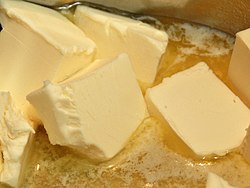Bread-and-butter plate Bread-and-butter plate (B&B plate) is a small, about 6 inches in diameter, plate that holds bread and butter for an individual table setting.[1] If a butter spreader is used, it is laid on top of the B&B plate, either vertically, horizontally, or diagonally.[2] The modern B&B plate is simply a smaller plate and has other uses, thus other names: side plate,[3] quarter plate,[4] cheese plate. UseThe availability of butter on the dining table varies with culture and setting and is closely related to the use of (otherwise dry) bread:[5]
In the Middle Ages, the trenchers were made of bread, but were not considered food, except by the poor, the bread intended for eating was served separately, on the left side (where the B&B plate is set up nowadays). A small dish, 2+1⁄2 to 3+1⁄2) inches in diameter, was used to hold a mound ("pat") of butter, and was called a butter pat. During the Victorian specialization "craze", two separate plates were used, one for bread and one for butter.[5]  The tendency of simplification after the First World War caused the plates to be combined into a single modern B&B one.[5] In 1918, a novel specialized bread plate with place for butter was marketed for restaurants as a way to enforce the wartime bead rationing and simplify service.[6] See also
References
Sources
|
Portal di Ensiklopedia Dunia














